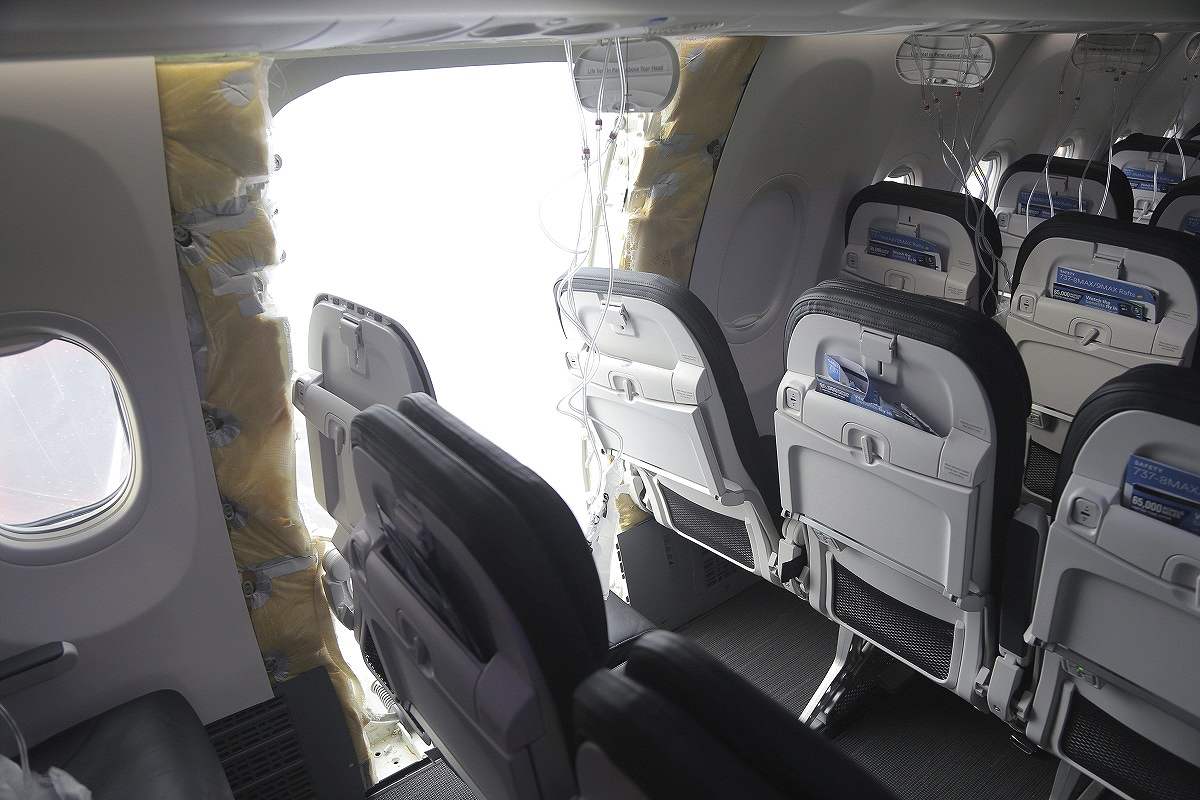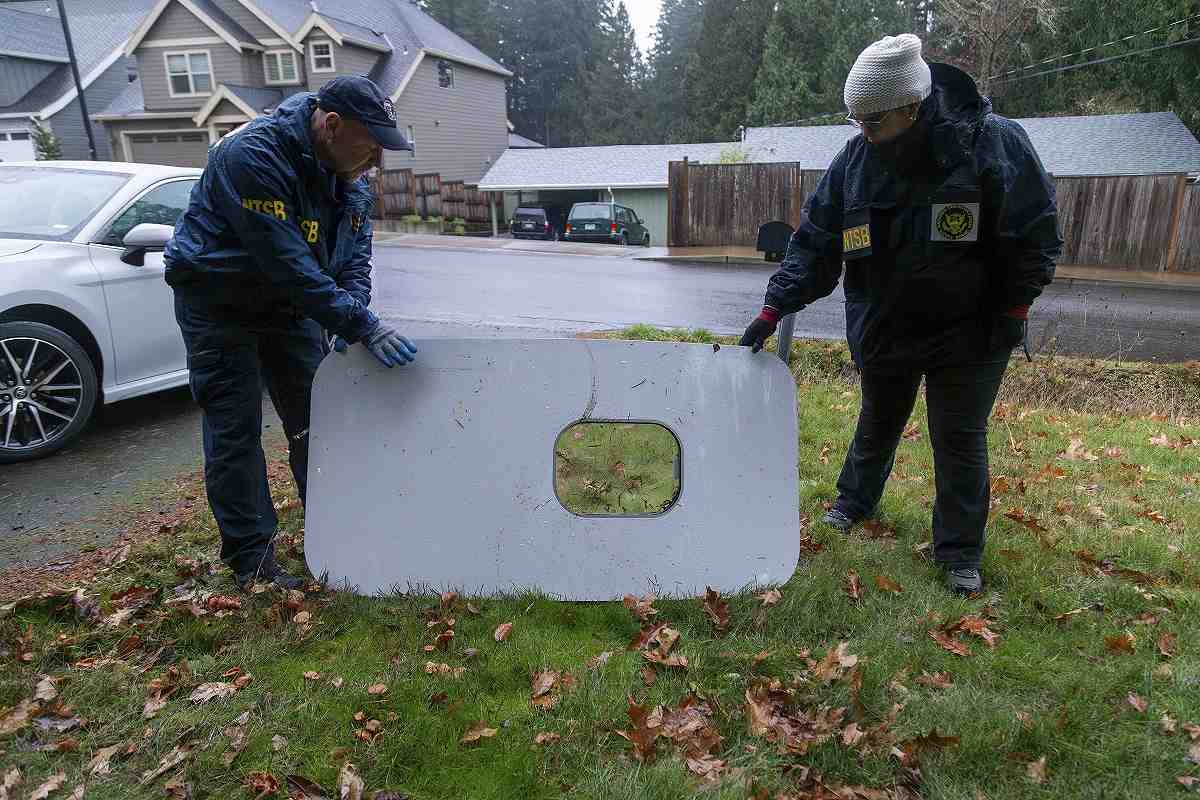US Investigating If Boeing Made Sure a Part that Blew off a Jet Was Made to Design Standards

This image taken Sunday, Jan. 7, 2024, and released by the National Transportation Safety Board, shows a section of Alaska Airlines Flight 1282 that is missing panel on a Boeing 737-9 MAX in Portland, Ore.
11:04 JST, January 12, 2024
The Federal Aviation Administration is investigating whether Boeing failed to make sure a panel that blew off a jetliner in midflight last week was safe and manufactured to meet the design that regulators approved.
Boeing said Thursday it would cooperate with the investigation, which is focusing on plugs used to fill spots for extra doors when those exits are not required for safety reasons on Boeing 737 Max 9 jetliners.
One of two plugs on an Alaska Airlines jetliner blew out shortly after the plane took off from Portland, Oregon, leaving a hole in the plane.
“This incident should have never happened,and it cannot happen again,” the FAA said. “Boeing’s manufacturing practices need to comply with the high safety standards they’re legally accountable to meet.”
The FAA notified Boeing of the investigation in a letter dated Wednesday.
“After the incident, the FAA was notified of additional discrepancies on other Boeing 737-9 airplanes,” an FAA official wrote. Alaska and United Airlines reported finding loose bolts on door plugs that they inspected in some of their other Max 9 jets.
The FAA asked Boeing to respond within 10 business days and tell the agency “the root cause” of the problem with the door plug and steps the company is taking to prevent a recurrence.
“We will cooperate fully and transparently with the FAA and the NTSB (National Transportation Safety Board) on their investigations,” said Boeing, which is headquartered in Arlington, Virginia.
Earlier this week, Boeing CEO David Calhoun called the incident “a quality escape.” He told employees that the company was “acknowledging our mistake … and that this event can never happen again.”
The door plugs are installed by Boeing supplier Spirit AeroSystems, but investigators have not said which company’s employees last worked on the plug on the Alaska plane that suffered the blowout.
The day after the blowout, the FAA grounded Max 9 jets, including all 65 operated by Alaska and 79 used by United Airlines, until Boeing develops inspection guidelines and planes can be examined. Alaska canceled all flights by Max 9s through Saturday.
NTSB investigators said this week they have not been able to find four bolts that are used to help secure the 63-pound door plug. They are not sure whether the bolts were there before the plane took off.
Despite a hole in the side of the plane, pilots were able to return to Portland and make an emergency landing. No serious injuries were reported.
A physics teacher in Cedar Hills, Oregon, found the missing door plug in his backyard two days later. It will be examined in the NTSB laboratory in Washington, D.C.
On Friday, a Seattle law firm filed a class-action lawsuit against Boeing, saying passengers on the Alaska flight suffered physical and psychological injury and emotional distress. It seeks unspecified damages for the treatment of health conditions, travel expenses and the loss of personal items. Boeing didn’t immediately return an email message seeking comment.
The FAA’s move to investigate Boeing comes as the agency is again under scrutiny for its oversight of the aircraft maker. Members of Congress have in the past accused the FAA of being too cozy with Boeing.
Sen. Maria Cantwell, D-Wash., chair of the Senate committee that oversees FAA, asked the agency to detail its oversight of the company.
“Recent accidents and incidents — including the expelled door plug on Alaska Airlines flight 1282 — call into question Boeing’s quality control,” Cantwell said in a letter to FAA Administrator Mike Whitaker. “In short, it appears that FAA’s oversight processes have not been effective in ensuring that Boeing produces airplanes that are in condition for safe operation, as required by law and by FAA regulations.”
The incident on the Alaska plane is the latest in a string of setbacks for Boeing that began in 2018, with the first of two crashes of Max 8 planes in Indonesia and Ethiopia — and more than four months apart — that killed a total of 346 people.
Justin Green, a lawyer who represents families suing Boeing for the Ethiopia crash, said he was happy to see the FAA ground the Max 9s so quickly after the Oregon incident.
“I would like to think it is because the FAA learned something after its failure to ground the Boeing 737-8 Max” after the first crash, Green said, “but you also need to consider that Alaska Air occurred in the U.S. with a plane full of U.S. citizens and garnered far more attention than the Lion Air crash” in Indonesia.
Max 8 and Max 9 planes were grounded worldwide for nearly two years after the second crash. Since then, various manufacturing flaws have at times held up deliveries of Max jets and a larger Boeing plane, the 787. Last month, the company asked airlines to inspect their Max jets for a loose bolt in the rudder-control system.

This photo released by the National Transportation Safety Board shows the door plug from Alaska Airlines Flight 1282 on Monday, Jan. 8, 2024, in Portland, Ore.
"News Services" POPULAR ARTICLE
-

American Playwright Jeremy O. Harris Arrested in Japan on Alleged Drug Smuggling
-

Japan’s Nikkei Stock Average as JGB Yields, Yen Rise on Rate-Hike Bets
-

Japan’s Nikkei Stock Average Licks Wounds after Selloff Sparked by BOJ Hike Bets (UPDATE 1)
-

Japanese Bond Yields Zoom, Stocks Slide as Rate Hike Looms
-

Japan’s Nikkei Stock Average Buoyed by Stable Yen; SoftBank’s Slide Caps Gains (UPDATE 1)
JN ACCESS RANKING
-

Keidanren Chairman Yoshinobu Tsutsui Visits Kashiwazaki-Kariwa Nuclear Power Plant; Inspects New Emergency Safety System
-

Imports of Rare Earths from China Facing Delays, May Be Caused by Deterioration of Japan-China Relations
-

University of Tokyo Professor Discusses Japanese Economic Security in Interview Ahead of Forum
-

Japan Pulls out of Vietnam Nuclear Project, Complicating Hanoi’s Power Plans
-

Govt Aims to Expand NISA Program Lineup, Abolish Age Restriction























